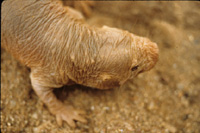
Only in the past 25 years have scientists learned of the strange lifestyle of African mole-rats. All 12 species live entirely underground. A few colonies of naked mole-rats, a social species of the family, have been raised for study purposes in a specially designed observation tunnels. (Texas Agricultural Experiment Station photo by Dr. Rodney Honeycutt)This is all underground, and naked mole-rats prefer it that way: Momma naked mole-rat is the only one having babies, and she's got several naked mole-rat boyfriends.
Were it human, the family would argue it out on a national talk show. As it is, the social behavior of these tiny rodents has scientists intrigued, right down to their naked mole-rat molecules. "African mole-rats are very good models for studying social structure. I'm interested in the genetic markers associated with structure," said Colleen Ingram, whose doctoral degree will be bestowed Friday at Texas A&M University based on her findings about the critters' parentage.
Ingram looked at regions of DNA - specifically the microsatellites, which represent distinct DNA bands, much like a satellite, which separate from the main DNA band. These rapidly changing regions of DNA don't code for any particular trait, as far as scientists can tell. Ingram thought these regions shouldn't be overlooked.
"If there is a random-mating population, there are a lot of sizes of those DNA bands, but a child only gets one set from the mother and one from the father," Ingram noted. These markers are used in paternity cases for humans, she said.
She looked for changes in the processes and patterns of this strand in mole-rats, she said.
"The current methods of analyses of microsatellite markers are oversimplified and may lead to incorrect conclusions when looking at natural populations and their social structures," Ingram said. "The relationship among members of the mole-rat family are well-accepted. Some species (of mole-rat) are strictly solitary while others, such as the naked mole-rat, are highly social."
DNA markers, like the satellites, are important because they can reveal how traits pass from one mother to her multitude of babies conceived by various interrelated fathers. That may help understand why scores of offspring in the family are willing to support the mother naked mole-rat.
But first, naked mole-rats. They live in Somalia, Ethiopia and Kenya. They are 3-6 inches long, have pink furless skin, tiny eyes which never see the light of day, and long front teeth for digging. Despite their tiny size, the naked mole-rat family den may stretch for 2 miles entirely underground, with various rooms. In one room, a plant root protrudes to provide a meal; in another is the "potty." When a new hallway is needed, usually for new food supplies, the naked mole-rat siblings form an earth moving chain to pass dirt out a hole which later is covered to block out intruders.
The most unusual room is the largest. It's where Momma naked mole-rat produces more babies – as many as 12 at a time every couple of months. Here she is stoked by her numerous mates and tended to by any number of offspring whose lot in life - if not to dig tunnels - is to keep Momma happy.
This behavior is common – even accepted and marveled over – in insects such as bees, termites and ants. But the naked mole-rat, a mammal, is the most advanced species to live in this arrangement, said Dr. Rodney Honeycutt, Texas A&M Univeristy wildlife professor whose 1992 article in American Scientist explained naked mole-rat life.
Scientists call it "eusocial" in that the young are cared for by the group, individuals in the group give up their ability to reproduce in order to do other jobs, and there are at least two generations that overlap to do the family's work, Honeycutt noted.
Why don't teenaged naked mole-rats revolt and head for their own tunnel? That's where genetics may play a role.
"Biological evolution is generally seen as a competition, a contest among individuals struggling to survive and reproduce," said Honeycutt, who was Ingram's lead professor and began studying mole-rats in the early 1980s while at Harvard
"It runs counter to everything we know about evolution," Honeycutt said. "In fact, (Charles) Darwin himself said social animals represent a real challenge to his theory (of natural selection and individual fitness)."
Honeycutt explained that after several generations of inbreeding, the offspring – say two sisters – may be more closely related to each other than to the parents. They preserve themselves by helping mother produce more offspring with their genetic makeup.
Knowing why animals exist with or without social structures could be more far reaching than the intricate underground tunnels of the naked mole-rat. What scientists learn about its genetic connection to social behavior could ultimately impact how endangered species, for example, are managed for survival, Ingram said. The fewer the animals of one species, the smaller its gene pool.
Ingram will continue her work with conservation genetics in her new position at the American Museum of Natural History in New York.
Source : Texas A&M University - Agricultural Communications
 Print Article
Print Article Mail to a Friend
Mail to a Friend
